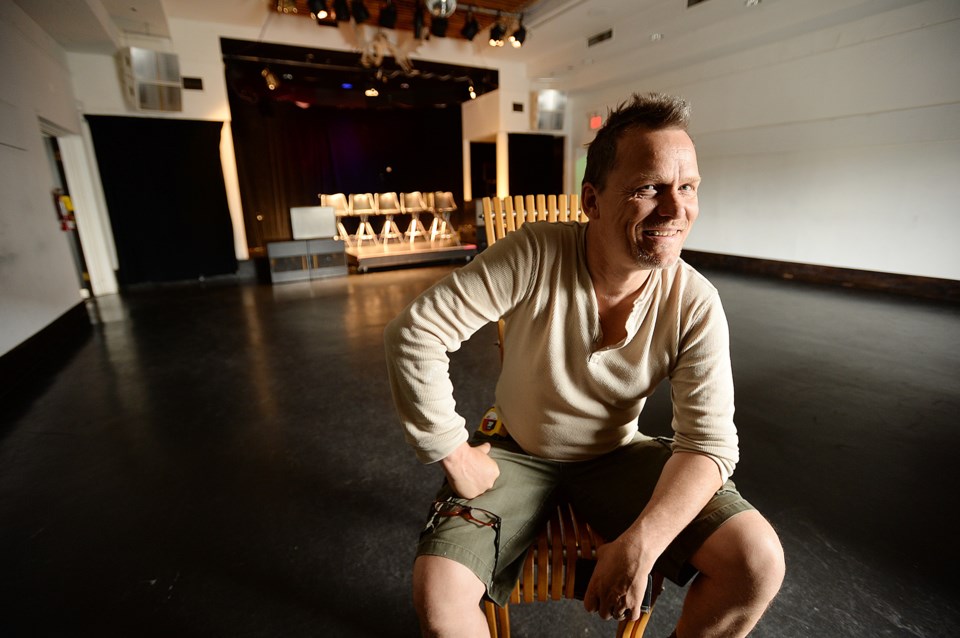Nathan Wiens of Wiens Studios is best known as a craftsman of custom wood furniture pieces that can be found in the homes of some of the city’s elite and in businesses around the world. But while his craft is his creative outlet, it is his East Vancouver arts studio, Chapel Arts, that is his labour of love.
The historic Art Deco former chapel and funeral home at 304 Dunlevy St. is now an eclectic space that reflects the many interests of its owner.
With a nod to his former days in the music industry as a builder, roadie and performer in the ’80s underground punk scene, the Chapel hosts various music acts such as Vancouver’s Hard Rock Miners. Reflecting his artistic bent, the Chapel’s white walls feature the works of Vancouver artists.
The Chapel also hosts community events such as a clown ensemble that performed in the Chapel’s theatre space earlier this month.
Wiens, 50, sat down this week for a Q&A with the Courier about Chapel Arts and being a part of the Downtown Eastside.
How did you come to own Chapel Arts?
Just over a decade ago, I was looking to relocate my furniture business from Yaletown. I was not looking to buy a funeral home, just a nice space for my studio. I found the garage that is now my woodworking studio across the street from the Chapel and fell in love with it.
The catch was the owner said I had to buy the Chapel as well. Once I owned the chapel, I envisioned it as a family, community arts and multi-use facility. The community is always screaming for such facilities, which remain scarce in the area, so it served a need.
Tell me about the history of the Chapel.
Before I bought it, it was likely the oldest operational funeral chapel on the West Coast. It was run for three generations by the Armstrong family and catered to the predominantly Asian clientele that was in this neighbourhood. It had a drive-through for hearses — the first drive-through in the city apparently.
The main part of the building was built in about 1911 and the add-on, with the drive-through, was built in 1936. It was all pink when I bought it, having been renovated in the 1970s — pink awnings and multi-toned pink inside. When I renovated, I tried to make it feel as it was back in 1936, including Marmoleum flooring, which was common in the 1930s.
What does being in East Vancouver mean to you?
East Van to me is the real Vancouver. I love its diversity, history and its characters.
I was in Yaletown 20 years ago and it was very much like this then. There were interesting people on corners and stuff in the alleys and plenty of activity. Now, it is this wall of gentrification and it is all trendy and lovely, but not gritty.
I searched everywhere for a new spot and I just kept coming back to the Downtown Eastside. There is a great vibrancy to the neighbourhood and a sense of community not matched in other areas.
You have been in the area for over nine years now, how has it changed?
There are more young business owners, especially in Chinatown. Otherwise it has stayed pretty much the same, which I like.
There are not a lot of highrises and it is still affordable for young entrepreneurs and independent businesses to set up here, at least for now. What has changed the most is people’s attitude.
When we first opened, it was next to impossible to get clients from outside of the area to come down or book events. This issue remains but is far less of an obstacle. People are realizing it is a vibrant area with lots to offer.
What do you see for the future the area and the Chapel?
With the new community plan, I believe we will remain a low-income community while diversifying and increasing density further east of the Chapel on Hastings Street. The new policies make predicting the Chapel’s future a challenge.
I hope to do a few more renovations to open the space up a bit so we can have more people in there. This will greatly increase the Chapel’s opportunity to serve the community and sustain itself as an independent community, cultural and heritage amenity. I remain optimistic.
For more information, go to chapelarts.com.



